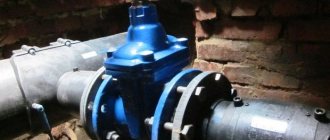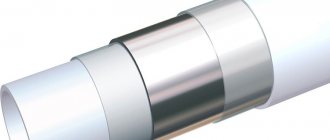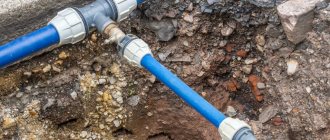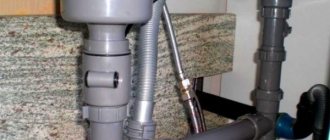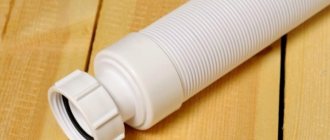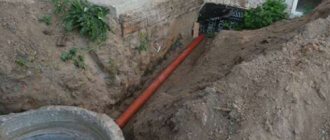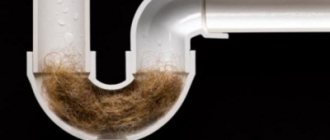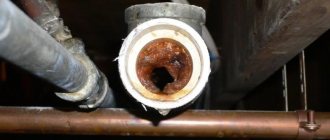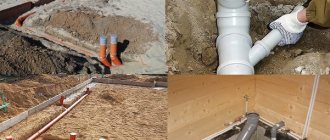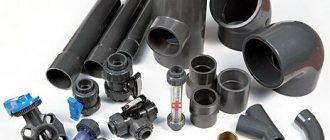How to connect a siphon to the sewer: selection and step-by-step installation instructions
09.11.2018
A siphon is a curved type of drain fitting that connects plumbing to the sewer system.
The product is necessary to form a water seal that prevents the passage of unpleasant odors from the waste system into the room.
Small debris is also retained in the bend, which reduces the likelihood of clogging.
Before you figure out how to connect a siphon to a sewer pipe, it is important to choose the right drain fittings.
Types of siphons
- Bottle (flask) - has a slightly expanded lower part. It is in this knee that small debris and fat are retained, which can be removed by partially disassembling the structure. The task can be simplified by washing with special cleaning agents. Ideal for kitchen sinks.
- Pipe - has a U- or S-shape. The design is non-removable, so there is a hole at the bottom of the product for servicing the drain. Suitable for connecting shower cabins, urinals, toilets.
- Corrugated pipe - it is easy to give such a siphon the desired shape, adjusting it to the location of the sewer outlet. The minimum number of connections and low weight significantly reduce the risk of leaks. At the same time, fat and small debris quickly accumulate in the folds of the corrugated material.
- The branched design is the best choice for a modern kitchen with a double sink and/or washing machine and dishwasher. Several outlets allow you to collect wastewater into one pipe.
- Combined system - is a universal bottle model with a corrugated hose.
- Products with overflow are a necessary solution for a bathtub that has a hole to prevent overflow.
- A drain is a special siphon for a bath or shower.
Types of sewer corrugated pipes
The sewer system is divided into two parts - internal and external. Therefore, all pipes used for sewerage installations are divided into internal and external; corrugated pipes are no exception.
A few more articles related to sewer pipes:
Corrugated pipe for internal sewerage
There is always not enough free space in houses, and even more so in apartments. And if you make a pipeline from ordinary pipes, you can still lose a significant part of the free space. Therefore, a corrugated pipe for internal sewage can become indispensable.
Most often, such products are made of small diameter, and you can find them under the sink or bathtub. A large diameter is not required here. The color of the inner pipes is white or light gray. In their production, practically no dyes are used, which makes the products even cheaper.
Some areas of indoor plumbing, such as those from a washing machine or dishwasher, carry hot water, so a heat-resistant corrugated drain pipe is required. The cost of such material will be higher than standard, but you cannot do without such a pipe.
Corrugated pipes for external sewerage
More recently, to lay the sewer pipeline outside, only cast iron and then thick-walled plastic tubes were used. Modern corrugated materials are ideal for these purposes, and in some cases they are even superior to their metal or plastic counterparts.
The main requirement for external sewerage material is frost resistance and low thermal conductivity. This allows you to avoid freezing of the system in winter. In addition, the pipe should not be sensitive to frequent temperature changes and, as a result, soil heaving.
External sewerage, as the name suggests, runs outside the building. Therefore, another requirement that applies to it is resistance to loads. A large layer of soil presses on the pipe, which runs underground. In addition, when pumping a septic tank, the pipeline is subject to pressure changes. It happens that some products cannot withstand this and burst. The corrugated pipe only bends under such loads, and then acquires its original appearance and size.
What to consider when choosing
- Features of connected plumbing equipment.
- Location of sewer pipe.
- Availability and volume of free space for installation of drain fittings, dimensions of the siphon and outlet.
- Choose a high-quality siphon for a cast iron pipe or plastic outlet that complies with GOST 23289–94.
- Characteristics of materials. Thus, plastic is lightweight, not subject to corrosion or rotting, but less durable than metal. Cast iron is reliable and durable, but has more weight. Copper alloys are universal, but expensive and become covered with a thin layer of oxides over time.
What is the siphon device used for?
A siphon device is an absolutely necessary item in any plumbing equipment. Structurally, it is a specially curved tube, at the bottom of the bend of which small debris accumulates, as well as a certain amount of water. Thanks to this, unpleasant odors from the sewer do not penetrate into the room. So they often talk about a siphon as a water seal device.
The siphon is the main obstacle to sewer odors, because this device technically connects the sink with the drain.
Installation of a siphon using the example of a plastic structure
- Fix the sink and connect the sewer pipe to it.
- Install a drain funnel with a rubber seal into the sink and tighten the nut for secure fixation.
- Connect the lower part of the siphon to the drain pipe.
- Place the drain tube in such a position that it does not reach the bottom of the flask 2-3 cm.
- Place union nuts and wedge-shaped “crackers” on the connecting pipes (each of them is inserted into the gap between the tube and the siphon and tightened with nuts).
Keep in mind that metal models are installed according to an identical scheme, but in them “crackers” replace flange connections.
Advice from professionals
Installing a siphon yourself is not at all difficult, especially if you look at a number of tips from professionals in advance. For example, when assembling siphons at home without the help of specialists, you need to carefully control the force with which the clamp is made. Otherwise, the device will be damaged otherwise. Particular care should be taken when fixing the gaskets when installing the lower plug and at other joints. A sealant is best for this. It should be remembered that the siphon parts must be tightened until they stop, but do not press hard.
When assembling the exhaust pipe, it is important to tighten the fastening screw well and also remove excess sealant. The installation height of the siphon can be adjusted precisely due to this part.
Experts advise that when purchasing a siphon, immediately check the presence of all parts in the kit. After all, sometimes by printing out the packaging at home, you may end up missing the necessary parts from the device. Also, when purchasing a device, you need to make sure that the thread is intact. It should be free of the slightest chips, burrs, and various protrusions that lead to disruption of the integrity of the gasket. When the siphon is assembled, all its parts must be cleaned and dried. Under no circumstances should there be sand or dirt on the seals. In the future they will lead to leaks.
For better drainage of liquid when installing the device, its outlet should be at a greater height from the floor than the inlet into the sewer. When choosing a siphon related to bottle models, it is worth considering that dirt may accumulate in the place where the water passes. In addition, they are not very durable. The best in terms of durability and corrosion resistance are bronze and brass siphons with galvanic coating. And stainless steel devices are very expensive, so they are not very popular.
When installing, do not overtighten the connections where there are threads, as they may need further adjustment. Too much force when fastening threaded connections often leads to failure. The force must be such that the rubber seal is pressed tightly to the landing site. This will make the joint fairly airtight.
Eliminate minor inaccuracies
Any defects during the installation of the siphon must be corrected immediately. If leaks are detected, it is necessary to check the reliability of the gaskets and the presence of cracks on them. It is also recommended to probe the pipe for delamination or damage. Leaks often occur when the nuts are too tightly or loosely tightened.
The smell of sewage in an apartment occurs for several reasons.
- No water lock. Often occurs when using corrugated pipes and not bending them sufficiently. Also, the water from the water seal could simply evaporate if no one lived in the apartment for a long time.
- Siphon malfunction. If you hear a squelching sound during drainage, this indicates a sharp jump in the drained water. The only solution is replacement.
- Small diameter of the sewer riser, faulty ventilation of the sewage system. The solution to such a problem must be entrusted to specialists.
Connection nuances, errors
It is worth noting that almost anyone, even an unprepared user, can cope with the task of how to connect a bathtub to a sewer.
However, in order to make the connection of the bathtub with the sewer pipeline technically competent, to avoid common mistakes, and to overcome difficulties that arise during the work, it does not hurt to take the advice of experienced plumbers.
Below are some common problems and solutions that a user may encounter:
- In the retail network you can find siphons with two outlet pipes, called audit siphons. Usually one of them is located above in a vertical or horizontal position, and the second is placed below it. Some users, having no idea what a water seal is and what it is needed for, mistakenly connect the outlet pipe of a corrugated pipe or rigid outlet to the lower drain hole, which is intended for inspecting (cleaning) the siphon from accumulated dirt (Figure 5). The result is a poorly functioning or missing water seal, leading to sewer odors in the room. It is also impossible to clean it without completely removing the entire siphon assembly.
- When connecting a rigid outlet from a siphon under a bathtub to a sewer pipe, some users connect a line consisting of numerous pipe sections to the tee. At the same time, almost everyone forgets the second option, by analogy with the mountain and Mohammed, when it is easier to route a 50 mm gray sewer pipe from the tee to the siphon.
Rice. 6 The position of the sewer pipes is too high when connecting - A common mistake made by many plumbers is placing the connection point to the sewer line too high relative to the bathtub bowl. For example, when a 50 mm pipe extends from a bathroom sink to a riser and a siphon is connected to it through a tee. In this case, a tee element is connected to the pipeline section at a point that is too high. As a result, the drainage of water from the bathtub slows down significantly, and the likelihood of blockages increases sharply. To properly connect the bathtub to the sewer, the tee should be carried as far down the slope of the sewer pipeline as possible to the riser.
- Usually, to insert a 50 mm tee, the sewer pipe is removed, a fragment is cut out in it, and a shaped element with an outlet is placed in the cut. But sometimes situations arise when it is not possible to remove a 50 mm pipe. In this case, an additional part called a coupling is used to insert the tee. It is a pipe section with double-sided sockets and rubber sealing rings. During installation, cut out a piece of pipe along the length of the tee insert, and place a coupling on one side of the pipeline flush with the end. A 50 mm tee is pulled onto the other side of the pipeline. Then the coupling is pushed along the pipe onto the tee branch, thereby finally fixing it in the pipeline section.
Rice. 7 Options for connecting a tee between pipes and into a pipeline section
Related article:
How to connect a kitchen faucet to a water supply using different types of pipes . If you don’t know how and how to connect a sink in the kitchen, be sure to read a separate article on our website. It explains all the details in great detail. tools, types of connections for different pipes and mixers.
Installation of a combined drainage system under the sink: operation diagram
Even an inexperienced home craftsman can install a siphon; just follow the step-by-step instructions for connecting sewer pipes to outlet fittings.
- We put a large flat gasket on the top of the flask-shaped unit and secure it with a lid. The product is ready for installation.
- We take a corrugated pipe, onto which at one end you need to put a union nut and a cone-shaped gasket. We insert this side into the siphon from the side and secure the structure with a nut.
- We repeat the operation with the pipe that goes into the upper part of the drain assembly.
- We put a gasket on the opposite end of the pipe and twist it with the drain, on which a nut is pre-installed.
- With one hand we hold the pipe, and with the other we install a metal drain with a rubber seal in the sink hole (this can be done in advance). Install and tighten the screw.
- We attach the corrugated siphon pipe to the drain system using an O-ring lubricated with sealant.
- We check the structure for leaks.
What criteria should you use to choose?
Of course, the first criterion you need to pay attention to is the manufacturer. It must be a reputable company, otherwise your purchase will not last long.
If your financial situation allows it, buy expensive products, in which case you will receive a guarantee for many years and will not encounter problems with breakdowns.
Also pay attention to the plumbing fixtures you are going to buy for. If it is standard, then in this case there should be no problems with either selection or installation
If the drain hole has standard dimensions, you can buy almost any model.
If your sink or bathtub is non-standard, then it is better to purchase it together with siphons. You will have to prepare for the fact that the cost of non-standard products will be much higher than standard ones.
When choosing, set at least the approximate amount of water and liquid that the corrugated siphon will need to pass through.
Along with the practical side, the factor of aesthetic appearance is important. It is necessary that the design fits harmoniously into the overall design and does not stand out.
When purchasing, do not hesitate to carefully inspect what you are purchasing, since you have every right to do so. Disassemble the product in the presence of consultants. Internal and external parts must not have any defects.
Experts say that their main advantage will be that they can be installed at a distance from the sewer. This opportunity is provided by corrugation, which can stretch. A socket is used for installation; the main material for its manufacture is stainless steel or plastic.
There are situations when the water is turned off, and you forgot to turn it off, and the sink is clogged, then the process of flooding the neighbors occurs. To avoid this, corrugated siphons with overflow were invented. In this case, excess water that has reached a critical maximum (and in this case, a hole) will go straight into the sewer. But there is no need to attach great importance to overflow. If the drainage system is clogged, no overflow will help.
This is a very popular plumbing device that is suitable for installation in sinks and bathrooms. It has great advantages and practically no disadvantages. This has led to its enormous popularity among users.
Connecting the toilet to the sewer
The toilet outlet can be positioned vertically, horizontally or at an angle of 45 degrees. In the first case, a direct connection to the sewer using a rubber cuff is sufficient. With a horizontal outlet, the simplest and most economical solution would be to install plastic pipes. The connection to the sewer can be strengthened with cement mortar.
If the drain is located at an angle, the siphon is connected using a corrugated pipe. With the help of an internal membrane, it is fixed on the pipe of a plumbing fixture, and with the help of an external membrane, it is fixed in the opening of the drainage system. It is recommended to use a reinforced version of a corrugated pipe or an eccentric type cuff.
Classification of sewer pipes
Corrugated pipes come in single-layer and double-layer types. The double-layer structure is more durable and can easily withstand soil pressure when used in underground sewer installations. The division of two-layer corrugated pipes for sewerage into types occurs due to the use of different materials for their production:
- Corrugated pipes made of polyvinyl chloride (PVC) are used in industrial sewerage systems, central drainage systems, and for sewerage systems of country houses. They withstand strong mechanical loads, do not become clogged during operation, have an operating temperature from -40 to + 50 degrees Celsius, with a short time interval of up to +90. Double-layer PVC sewer pipes do not corrode, are environmentally friendly, can be installed to a depth of up to 15 meters, and have a shelf life of up to 50 years. The color of corrugated pipes for external sewerage can be orange, gray and yellow.
- Corrugated pipes made of polypropylene (PP). Ideal for chemically contaminated soil and used for drainage, external and storm sewer systems. They can withstand temperature changes from -20 to +95 degrees Celsius, have increased mechanical strength, suitable for soil with sand, gravel, etc. Not susceptible to the effects of chemical formations in liquid waste.
- Corrugated pipes made of low pressure polyethylene (HDPE). They have the same properties as PVC pipes. They are: environmentally friendly, withstand a wide range of temperature differences, increased tightness and ease of dismantling and repair.
Installation of double-layer corrugated pipes
Prices
The cost of the product depends on the material from which it is made.
- A plastic siphon-corrugation or a bottle-type device with a corrugated pipe will cost from 100 to 300 rubles.
- The price of a product made of chrome-plated plastic will be 350–700 rubles.
- A metal folding siphon costs much more than a plastic one - 3-5 thousand rubles.
Summarize
Assembling a siphon for a sink, washbasin, shower cabin or bathtub does not take much time and does not require special skills. However, there are a number of nuances that you should be aware of and take into account so that you do not have to do double work by redoing something. You need to take everything into account so that you don’t soon need to replace a completely new device with a more functional model, because you forgot to take into account that you will place a washing machine nearby and it will also need to be connected to the sewer through a siphon.
If you are new to plumbing and are installing a siphon for the first time, the manufacturer’s instructions for the product may be incomprehensible in some ways. Having only a schematic description of the assembly and installation sequence of the device, it does not contain important information and tips that will help you avoid mistakes and protect your kitchen from sewer leaks.

